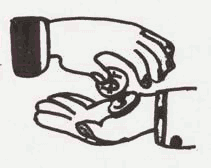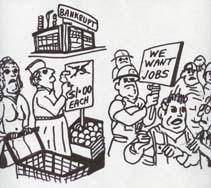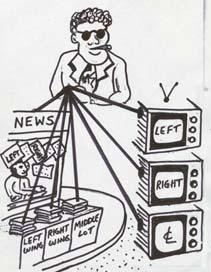“Why is there no money left?”
Contents: Headlines in 2010 - Basic problem 1: interest - Basic problem 2: origin of the money - Consequence: a constant redistribution from poor to rich - Solutions! - Links
Headlines in 2010
Since I currently do not follow any English-speaking newspapers I must refer to the Wikipedia article about the financial crisis of 2007 to the present, which also includes a lot of information on the situation in the European Union and Greece. This whole page is not an exact translation of the German original, but uses different quotations and gives different (and less!) recommendations for further reading.
Basic problem 1: Interest
Something must give when the mathematics of interest-bearing debt overwhelms the economy’s ability to pay. For awhile the growing debt burden may be met by selling off or forfeiting property to creditors, but an active public policy response is needed to save the economy’s land and natural resources, mines and public monopolies, physical capital and other productive assets from being lost to creditors.
From Michael Hudson’s Why the “Miracle of Compound Interest” leads to Financial Crises (2007)
| $100 “invested” (or owed) at different interest rates | ||||||
| 1.00% | 2.00% | 3.00% | 5.00% | 7.00% | 10.00% | |
|---|---|---|---|---|---|---|
| 10 years | 110.46 | 121.90 | 134.39 | 162.89 | 196.72 | 259.37 |
| 20 years | 122.02 | 148.59 | 180.61 | 265.33 | 386.97 | 672.75 |
| 30 years | 134.78 | 181.14 | 242.73 | 432.19 | 761.23 | 1744.94 |
| 40 years | 148.89 | 220.80 | 326.20 | 704.00 | 1497.45 | 4525.93 |
| 50 years | 164.46 | 269.16 | 438.39 | 1146.74 | 2945.70 | 11739.09 |
| 60 years | 181.67 | 328.10 | 589.16 | 1867.92 | 5794.64 | 30448.16 |
| 70 years | 200.68 | 399.96 | 791.78 | 3042.64 | 11398.94 | 78974.70 |
| 80 years | 221.67 | 487.54 | 1064.09 | 4956.14 | 22423.44 | 204840.02 |
| 90 years | 244.86 | 594.31 | 1430.05 | 8073.04 | 44110.30 | 531302.26 |
| 100 years | 270.48 | 724.46 | 1921.86 | 13150.13 | 86771.63 | 1378061.23 |
| doubling in: | < 70 y | < 36 y | < 24 y | < 15 y | < 11 y | < 8 y |
Basic problem 2: Origin of the money / being forced into dept

The system of banking we have both equally and ever reprobated. I contemplate it as a blot left in all our constitutions, which if not covered, will end in their destruction, which is already hit by the gamblers in corruption, and is sweeping away in its progress the fortunes and morals of our citizens. [...] And I sincerely believe, with you, that banking establishments are more dangerous than standing armies; and that the principle of spending money to be paid by posterity, under the name of funding, is but swindling futurity on a large scale.
Thomas Jefferson (1743-1826), Third President of the United States, in a letter on republican government to philosopher John Taylor.

 The story The Earth Plus 5% written by the Australian Larry Hannigan in 1971, strikingly explains why money at first was good for most people, but in the course of time made more and more of them fall into poverty. Thus our current money became the culprit for the worst of crimes, especially the constant wars. Incidentally it does not matter whether you see evil forces at work, as the story suggests, or if you consider it an unfortunate automatism of the money produced so far: the interest system’s repercussions described in the story and currently witnessed by us are real.
When you click the link the the story you also get to hear the text, if your computer supports sound. If English is not your preferred language there is an extensive list of translations available (albeit without the audio version): Bulgarian, Catalan, Czech, Dansk, English, Español, Francais, German, Italian, Japanese, Latvian Malay, Indonesian, Polski, Portugues, Russian, Serbo-Croatian, Turkish, Urdu.
The story The Earth Plus 5% written by the Australian Larry Hannigan in 1971, strikingly explains why money at first was good for most people, but in the course of time made more and more of them fall into poverty. Thus our current money became the culprit for the worst of crimes, especially the constant wars. Incidentally it does not matter whether you see evil forces at work, as the story suggests, or if you consider it an unfortunate automatism of the money produced so far: the interest system’s repercussions described in the story and currently witnessed by us are real.
When you click the link the the story you also get to hear the text, if your computer supports sound. If English is not your preferred language there is an extensive list of translations available (albeit without the audio version): Bulgarian, Catalan, Czech, Dansk, English, Español, Francais, German, Italian, Japanese, Latvian Malay, Indonesian, Polski, Portugues, Russian, Serbo-Croatian, Turkish, Urdu.
Consequence: a constant redistribution from poor to rich
My redistribution calculator allows everyone to experiment with his or her own values for capital and interest!
Solutions!
Money requires the State, without a State money is not possible; indeed the foundation of the State may be said to date from the introduction of money.
Silvio Gesell in The Natural Economic Order (1920)
I chose this quote to show that the existing (i.e. produced by the European Central Bank, the Federal Reserve, or their respective counterparts) money needs not be accepted as “natural”. In fact it is just an agreement between men, which can be cancelled or modified.

I pin a lot of hope on a new money like the “Freigeld” Silvio Gesell describes it his book The Natural Economic Order. The full text of the book seems to be available online in English, French, German, Spanish, and Italian.
Based on Silvio Gesell’s ideas (“on the shoulders of giants”) I developed the concept of an online market place with its own neutral money: freimarkt.org
I hope to be able to make this operational as soon as possible - or for someone else to implement the concept!
Links
- Bob Marley - Rat Race “It’s a disgrace to see the human race in this rat race!”
- John Butler Trio - Revolution “All kicking and scrounging for the very first place / dictionary definition of a rat race”
- Beatles - Can’t Buy Me Love „I don’t care too much for money...“
- Michael Jackson - Money “You say you wouldn’t do it for all the money in the world? I don’t think so.”
- Tim Beam - The Ghost of my Money A video with nice pictures from the not too exciting movie „Der Geist des Geldes“ (The Spirit of Money).
- Money as Debt is a simple but thrilling documentary on the history and creation of our current money. Possible alternatives are discussed on the website and in the film, which is available for free download.
- Let’s make MONEY (IMDB entry) a calm, shocking, and great documentary with cineastic pictures.
- Life and Debt - A haunting documentary on what the policies of the IMF lead to.
The ideas of and the motivations for the monetary reform proposed on this website are related to the ideas behind a basic income guarantee - so I conclude by “quoting” a pictogram the Pirate Party Berlin uses to advertise the basic income guarantee:
 Foto:
Foto: